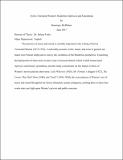Sylvia Townsend Warner's Modernist Ekphrasis And Synesthesia
Author
McMahon, Rosemary
Abstract
The presence of music and sound is crucially important in the writing of Sylvia Townsend Warner (1873-1978). A noticeably acoustic writer, music, and noise in general, are major tools Warner employed to convey the vacillation of the Modernist perspective. Examining the deployment of these tools reveals a type of musical rhetoric which is built around aural ekphrasis and literary synesthesia, and this study concentrates on this feature of three of Warner's novels and one short story: Lolly Willowes (1926), Mr. Fortune's Maggot (1927), The Corner That Held Them (1948), and "Emil" (1956). While the exact patterns of Warner's use of music and sound throughout her fiction ultimately remain ambiguous, probing them in these four works does cast light upon Warner's private and public concerns.
Date
2017-07-18
Citation:
APA:
McMahon, Rosemary.
(July 2017).
Sylvia Townsend Warner's Modernist Ekphrasis And Synesthesia
(Master's Thesis, East Carolina University). Retrieved from the Scholarship.
(http://hdl.handle.net/10342/6337.)
MLA:
McMahon, Rosemary.
Sylvia Townsend Warner's Modernist Ekphrasis And Synesthesia.
Master's Thesis. East Carolina University,
July 2017. The Scholarship.
http://hdl.handle.net/10342/6337.
June 29, 2024.
Chicago:
McMahon, Rosemary,
“Sylvia Townsend Warner's Modernist Ekphrasis And Synesthesia”
(Master's Thesis., East Carolina University,
July 2017).
AMA:
McMahon, Rosemary.
Sylvia Townsend Warner's Modernist Ekphrasis And Synesthesia
[Master's Thesis]. Greenville, NC: East Carolina University;
July 2017.
Collections
Publisher
East Carolina University

